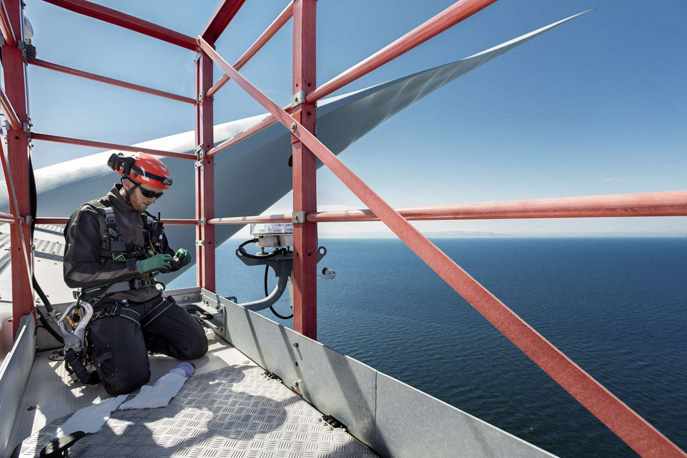SPONSORED CONTENT: By Filip Engel Vice President, Sustainability, Public Affairs and Branding for Ørsted
Climate politics, as COP26 last month proved, is complex and messy. But beyond the rhetoric and negotiations, one thing remains clear: tackling the climate crisis will require an unprecedented build-out of renewable energy. As an illustration, the European Union this year increased its renewable energy target to 40% by 2030, meaning the EU will need 451 GW of wind power capacity by 2030, equivalent to the installation of 30 GW of new wind farms every year. By comparison, the world’s largest offshore wind farm – the UK’s Hornsea One, developed by Ørsted – has a capacity of 1.2 GW.
To meet these kinds of highly ambitious targets, all actors – governments, developers, manufacturers, suppliers – must rapidly accelerate their ambitions and capabilities. We simply need to build and install much, much more renewable energy infrastructure: onshore and offshore windfarms, solar and storage, power-to-X. However, as we mobilise to deliver the renewables build-out at the scale and speed required by climate science, it is vital that we keep in mind an equally significant and related crisis: biodiversity loss and ecosystem destruction.
A 2019 report from the Intergovernmental Science-Policy Platform on Biodiversity and Ecosystem Services (IPBES) found that one million species are threatened with extinction, many within decades, because of humanity’s activities. Over the past 50 years, through increased population growth and associated activities such as deforestation, overfishing and pollution, humans have consumed and degraded biodiversity and ecosystems more rapidly than at any other time in human history. Biodiversity is our life support system, and is now itself on life support.

To be a leader in sustainability today means taking decisive action on both these issues: climate and nature. Operating in the energy sector, we at Ørsted are acutely aware of this interconnection. Moreover, our position as the world’s most sustainable energy company gives us a unique opportunity to positively impact both areas. Our vision is a world that runs entirely on green energy, so we have a crucial role to play in the renewable energy build-out. And we are committed to understanding and addressing the biodiversity impact of our industry as we do this.
The challenge is particularly urgent in the marine environment. Loss of marine biodiversity is weakening the ocean’s role as a key global climate regulator, while ocean-based infrastructure plays a critical role in all paths to net zero. To limit global heating to 1.5C, while also improving the health of our oceans and the potential of ocean-based climate adaptation and mitigation actions, we need wind energy to be delivered in balance with nature.
At Ørsted, we already work to avoid, mitigate and address the potential biodiversity impact of our offshore wind projects, with one of the renewable energy industry's most experienced in-house teams of environment specialists. We have delivered initiatives such as artificial reefs to support Atlantic cod at Borssele 1 & 2 in the Netherlands; monitoring of crustacean habitats at Westermost Rough in the UK; and a programme to protect and conserve the North Atlantic right whale.
In 2021, though, we went one step further, targeting net-positive biodiversity impact for all new renewable energy projects we commission, from 2030 at the latest. This kind of commitment is new territory – for us and for the energy industry. We don’t yet have all the answers, but we believe that public and ambitious commitments serve to motivate and spur action – both from us and from the wider industry.

The good news is that we at Ørsted have an unparalleled wealth of experience and data in developing, constructing and operating offshore wind. Drawing on this, we are working on how to meaningfully measure biodiversity impact in the dynamic ocean environment. This is a significant challenge because marine biodiversity involves interconnected and highly mobile or difficult-to-reach ecosystems. But measurement is at the foundation of any biodiversity program, because we need to be able to demonstrate which activities are generating positive outcomes. We also want to invest in nature-positive projects and learn from them to develop a suite of net positive biodiversity measures the scientific community can stand behind.
In parallel, we are working to stimulate the international debate and collaboration needed to bring about a global step-change in how we think about integration of climate and biodiversity goals and plans to meet them. This is not a challenge we can solve on our own. Global plans for reaching net zero, improving food security and creating shared prosperity all mean increasing use of marine space and associated environmental pressures. Collaboration across multiple ocean actors is needed as we find a new approach to ocean stewardship that aligns climate and biodiversity goals and enables a sustainable and inclusive ocean economy.
The energy transition only makes sense in balance with nature, which is why we have put biodiversity at the core of our sustainability strategy. Our ambition is necessarily high. We will all likely make mistakes along the way as we learn how to do this together. But this is a journey we must undertake, today. Without concerted effort, global biodiversity will come under ever greater pressure until it is unable to sustain itself, or us, any longer.
COP26 offshore wind renewable energy biodiversity North Atlantic right whale IPBES Ørsted

